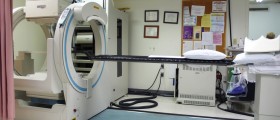Prostate cancer is a malignant tumor which generally affects men older than the age of 50. The tumor develops inside the gland located just below the bladder. The disease has its own specific course and goes through a few stages. Progression of prostate cancer is individual and first symptoms occur when the tumor becomes large enough and initiates compression or infiltrates nearby organs and tissues. It can be also diagnosed accidentally. Unfortunately, prostate cancer may remain asymptomatic for a long period of time. In such case it is diagnosed late, when it has already given bone metastases.

Life Expectancy for Patient with Prostate Cancer
End stage prostate cancer (terminal stage of prostate cancer) is advanced disease. It has its own symptoms and signs which may vary from patient to patient but what is common for all people with end stage of the disease is soon, inevitable lethal outcome. End stage prostate cancer is simply incurable.
- Stage 1 means the cancer is in only half of one side of the prostate, or less. It is completely contained within the prostate gland. Almost everyone (almost 100%) will survive their cancer for 5 years or more after they are diagnosed.
- Stage 2 means the cancer is in more than half of one side of the prostate. But it is still completely contained within the prostate gland. Almost everyone (almost 100%) will survive their cancer for 5 years or more after they are diagnosed.
- Stage 3 means the cancer has broken through the covering (capsule) of the prostate gland. It may have spread into tubes that carry semen (seminal vesicles). Around 95 out of every 100 men (around 95%) will survive their cancer for 5 years or more after diagnosis.
- Stage 4 can mean different things, including: the cancer has spread into nearby body organs, such as the back passage or bladder; the cancer has spread to nearby lymph nodes; the cancer has spread to other parts of the body outside the pelvis, such as the lungs or liver. Around 50 out of every 100 men (around 50%) will survive their cancer for 5 years or more after they are diagnosed.
End Stage Prostate Cancer Clinical Characteristics
Depending on the size of the tumor, its location, infiltration of the nearby tissues as well as spread to regional lymph nodes and bones, patients suffering from end stage prostate cancer may have to face different health problems. Most of them complain about pain in lower back, hips and upper legs (bone metastases). Furthermore, infiltration of the bladder is accompanied by blood in urine and painful urination. There may also be urine retention/incontinence). Additional symptoms include lethargy, generalized body aches and sexual difficulties.
End Stage Prostate Cancer Treatment
There are several treatment modalities for people suffering from end stage prostate cancer. There are hormonal therapy, chemotherapy, trans-urethral resection of the prostate, pain management and radiation therapy. All of the mentioned therapies are not engaged to cure the patients but to ease their pain and all the accompanying, unpleasant and unbearable symptoms. Therefore, this treatment is called palliative.
Side Effects of Treatment
Many times patients who have to deal with bone metastases feel excruciating pain. Such issue can be only dealt with strong pain killers or radiation therapy.
The goal of the treatment in the terminal stage is also to focus on patient's quality of life and do as much as possible to alleviate all the inconveniences one has to deal with.
Support Groups
Plenty of good advice can be obtained from support groups for end stage prostate cancer. And finally, there are different alternative treatments that are currently studied and may one day be of great help for such patients. Until then, certain help can be obtained from vitamin D supplements, shiitake mushrooms etc.

















Your thoughts on this
Loading...